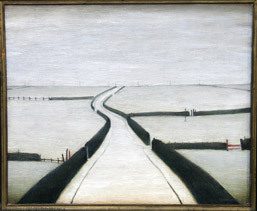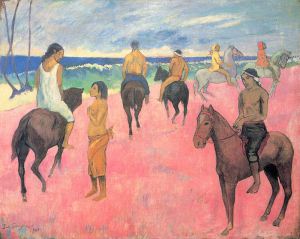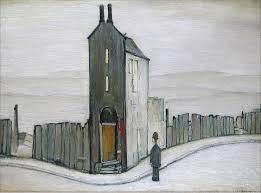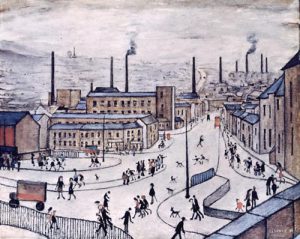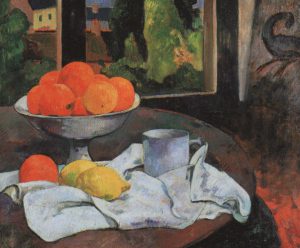L.S. Lowry and Paul Gauguin: Sinister Realities and Strong Individualism
Lee Jay Walker
Modern Tokyo Times
L.S. Lowry (1887-1976) became one of the greatest artists in Britain during the twentieth century despite facing many obstacles related to his artistic style. After all, his style was very individualistic alongside being extremely broad. Northern English people can certainly relate to the industrial landscapes and the world he was portraying. Therefore, Lowry, just like Paul Gauguin, but for very different reasons, highlighted their respective deep passions based on going against the grain in many diverse areas related to art and ideas.
Gauguin entered the art world at a late stage in his life because prior to turning to art he lived a very conventional lifestyle. On the other hand, Lowry says: “If people call me a Sunday painter I’m a Sunday painter who paints every day of the week!” This comment by Lowry highlights his roots because it shows no weakness and enormous self-belief. Also, Lowry didn’t seek compassion because his art would do the talking therefore people can either accept his uniqueness or reject it. Either way, Lowry didn’t desire compliance because he held firm to what made him special. However, in saying this, it must be stated that his art is more diverse than most people give him credit for.
Lowry and Gauguin are very different characters and the same applies to their art and thought-patterns. For example, Lowry was based on non-elitism but Gauguin had a certain elitist way of thinking when related to his art and certain circles he mixed in. In this sense, Lowry applies to the non-elitist world whereby his art can be felt within the environment he came from and the world that he witnessed. However, Gauguin noticed and expressed the difference between the artist and art lover alongside citizens who couldn’t feel the same passion.
Also, Gauguin desired acceptance and to be understood for the genius that he was. Only after so much hardship related to economic factors and the death of two of his children did Gauguin gradually come to reject the world around him. Therefore, in time Lowry and Gauguin would feel the raw and harsh world around them.
Ford Madox Brown and Rossetti influenced Lowry to different degrees. Likewise, Lowry had deep knowledge of French Impressionism therefore he was open to different concepts. He studied at the Manchester Academy of Fine Art and at Salford Royal Technical College. However, Lowry was not a follower of any individual and instead he focused on his own unique style. This individualistic style became the backbone of his career despite also producing more conventional paintings.
Gauguin on the other hand “glimpsed poetry” and had “a spark of high intensity.” He also stated that “without art there is no salvation” but in many ways his life became one of hardship based on turning to art. Also, images of Tahiti continue to prevent “a complete artistic salvation” because this aspect of his life is held again Gauguin in certain artistic circles.
In another article I comment: “Many art critics have no right to enforce their snobbery against Gauguin or to condemn him rashly because time never keeps still and concepts are always changing. In other words, no individual can put themselves in the place of another – and unless people understand the times of the day and link this with the death of his children and the severe poverty he faced – alongside the onset of time that was eating away at his soul – then who can really judge Gauguin given the many torments that he faced in his life?”
Therefore, the artwork of Gauguin should provide “artistic salvation” because very few artists have left a legacy of such richness in comparison to Gauguin. Also, the “intensity” he had can be seen throughout his artwork because this individual artist was a genius – irrespective if a flawed genius or not. Sadly, the bleakness of parts of his life meant that he eventually succumbed to “a dream world” based either “on the flesh” or “unrealism” because paradise was lost once humans walked this earth.
Lowry and Gauguin both had rare individualism and strong souls that maintained them when others would have faltered based on so many difficult obstacles. After all, irrespective of the negatives aimed at Lowry by some art critics – and periods of real poverty for Gauguin and the isolation he felt after two of his children died – both individuals never succumbed to self-doubt about their artistic merits and this says much about both amazing artists.
In an earlier article I stress: that “Images by Lowry can lead to confusion for people outside of a working class environment and who don’t understand the real power and energy of industrial landscapes.”
Lowry himself commented that “One day I missed a train from Pendlebury – (a place) I had ignored for seven years – and as I left the station I saw the Acme Spinning Company’s mill … The huge black framework of rows of yellow-lit windows standing up against the sad, damp charged afternoon sky. The mill was turning out… I watched this scene – which I’d looked at many times without seeing – with rapture…”
One place where Lowry and Gauguin could meet is in the area of isolation. Lowry in his art felt a deep connection with individuals who were solitary and struggled to cope with this life. Therefore, Gauguin during times of poverty and despair would have been a perfect individual for Lowry to draw. Also, given the artistic nature of both then this binding factor linked with “despair” and the feeling of “abandonment,” would have made for interesting friends if they had they shared the same time and environment.
Of course, this is wandering into the world of “if” and “unreality.” However, without imagination then where is creativity? For Gauguin “creativity” was everywhere because he could turn the “mundane” into something “dramatic.”
Gauguin sometimes entered the world of despair and isolation yet art that had created his poverty also pulled him out of despair. In this sense, Gauguin had art throughout his veins because his world was shaped and engulfed by his intensity towards art.
Individuals split people into elite international artists, national artists, regional artists and so forth. However, irrespective of this both Lowry and Gauguin were rare artistic individuals because their love of art shines through at all times.
http://www.guardian.co.uk/artanddesign/2010/sep/27/paul-gauguin-tate-modern-exhibition PLEASE WATCH THIS LOVELY VIDEO
http://www.thelowry.com/ls-lowry/the-ls-lowry-collection/
http://toshidama.wordpress.com/2010/10/27/gauguin-in-print/
Modern Tokyo News is part of the Modern Tokyo Times group
http://moderntokyotimes.com Modern Tokyo Times – International News and Japan News
http://sawandjay.com Modern Tokyo Times – Fashion
https://moderntokyonews.com Modern Tokyo News – Tokyo News and International News
http://global-security-news.com Global Security News – Geopolitics and Terrorism
PLEASE JOIN ON TWITTER
https://twitter.com/MTT_News Modern Tokyo Times
PLEASE JOIN ON FACEBOOK
